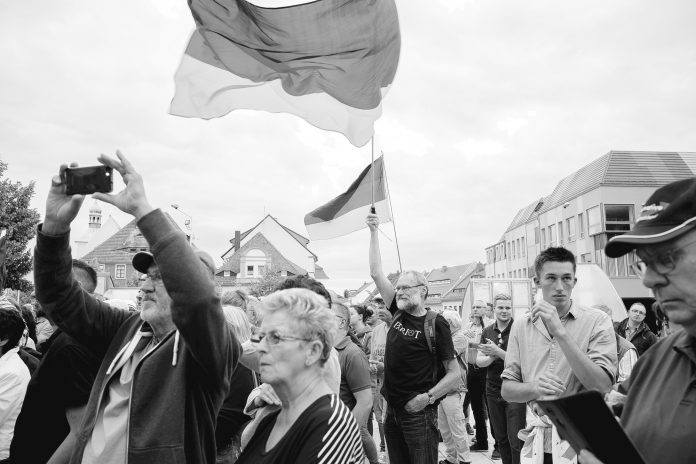
As the sun sets over the medieval towers of Bautzen, crowds flock to the market square. Most are old, white men. A few wave German flags as they gather for a rally with leaders of the far-right Alternative for Germany party.
Supporters of the party, which hopes to make big gains Sunday in two state elections, are quick to blame Chancellor Angela Merkel and her center-right Christian Democratic Union for their region’s woes.
“We need a change,” retiree Volker Nowak said as he stood among some 500 followers of the party known as AfD. “It’s only the old people left behind here … We don’t have any doctors, any nurses, any teachers, any tradesmen and also any youth.” The CDU “ruined everything.”
The votes in Saxony — which includes Bautzen, a hilltop town of 40,000, and neighboring Brandenburg — threaten to deliver another blow to Germany’s traditional big parties and further destabilize Merkel’s national coalition government. Coming weeks before the 30th anniversary of the fall of the Berlin Wall, the elections are also likely to highlight the economic and social issues that still divide the country more than a generation after reunification.
The formerly communist east, and Saxony in particular, has become a stronghold for the 6-year-old AfD, which is eyeing a possible first-place finish in both states.
Many people in Germany’s rural, eastern periphery feel left behind. Some never recovered from losing their jobs after the wall fell. Promises of equal living standards did not always become reality, and salaries in the east still lag behind those in the west. Many young people left long ago.
The CDU has governed Saxony since reunification in 1990, first with an absolute majority and more recently with coalitions. Polls for a time showed it neck-and-neck with the AfD, but recent surveys put it a few points ahead, with support around 30% — down from 39% five years ago. The AfD appears set to more than double its 9.7% score from 2014.
Neither Merkel’s CDU nor the center-left Social Democrats — Merkel’s partners in the tense national “grand coalition” — will form a coalition with the AfD. But the far-right party’s strength could make forming new governments in both states difficult.
Saxony has been a hotbed of far-right groups. It is not only a bastion of the AfD, but also the state where the anti-migration group PEGIDA —Patriotic Europeans against the Islamization of the West — rose to prominence with weekly protests in Dresden that brought tens of thousands of supporters into the streets at the height of the 2015 migration crisis.
Following a killing of a German man by a Syrian asylum seeker last summer, the Saxon city of Chemnitz saw days of anti-foreigner riots by thousands of neo-Nazis and members of the AfD.
“The AfD is offering something that the people in Saxony and in the east are missing in general: a sense of belonging and a sense of rebellion,” said Johannes Staemmler, a political scientist from the Institute for Advanced Stability Studies in Potsdam.
There is also a strong sense of disillusionment, especially in villages where people feel that they don’t “play a role” and that their own state government doesn’t care about them anymore, Staemmler added.
Tapping into that mood, the AfD has put up election posters urging voters to “complete” the 1989 rebellion against communist rule and proclaiming that “the east is rising up.”
Saxony’s 5.3% unemployment rate is only a little above the national rate of 5%, and below the east’s average 6.3%. Its big cities, such as Dresden and Leipzig, have been widely renovated and attracted new companies. But rural regions have not yet recovered from de-industrialization three decades ago, when communist-era companies and agricultural collectives ceased to be competitive and tens of thousands of jobs were lost.
Older eastern voters in particular sometimes nourish nostalgic feelings about the past and are fearful of the future, particularly with an economic downturn looming in Germany and beyond. The AfD plays on those fears.
The AfD’s leader in Saxony, Joerg Urban, pledged to the crowd in Bautzen that his party would improve rural infrastructure, achieve faster internet, improve cellphone reception, build new schools and attract more doctors. He also promised to hire more police and speed up deportations of rejected asylum-seekers. Party members distributed flyers promoting increased border controls and a ban on the construction of mosques with minarets.
Bautzen has a relatively low proportion of foreigners, 4.6% compared with more than 11% nationally, a figure that encompasses everyone from European immigrants to war refugees. But anti-foreigner sentiment and criticism of Merkel’s 2015 decision to admit large numbers of migrants from Syria and elsewhere falls on fertile ground here.
The town made headlines when clashes broke out between residents and asylum-seekers in 2016. Though the number of new asylum seekers reaching Germany has since declined sharply, the AfD’s anti-migrant stance helped solidify its support in eastern Germany. In the small villages surrounding Bautzen, AfD banners are often the only campaign posters on deserted main streets.
Urban said in an interview with The Associated Press that his party wants the election “to be a signal for all of Germany” that the AfD is “accepted by wide parts of society.”
Changes such as globalization and digitalization are weakening voters’ attachment to traditional parties, said Hans Vorlaender, a political scientist from the Technical University of Dresden.
“We can currently see big changes in societies everywhere,” he said. “We see how the traditional party systems that gave stability to democracy have imploded in countries like Italy or France.”
Germany isn’t in a comparable situation yet, but voting patterns in the east could foreshadow developments nationwide, Vorlaender said.q















